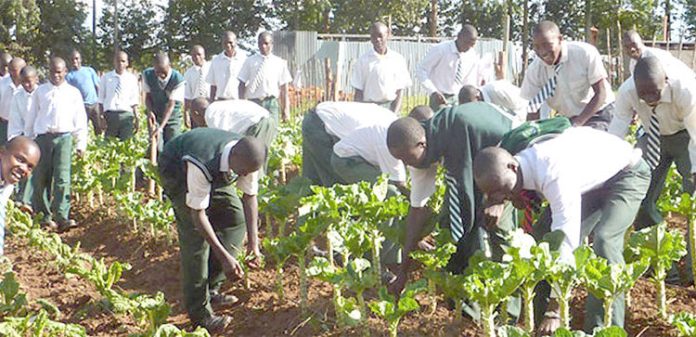AGRICULTURE is one of the earliest occupations of mankind. The Holy Scriptures, in Genesis Chapter 1, Verses 26-30; and in particular, Genesis Chapter 2, Verse 15; tells us that when God created man, He gave him the work of cultivating the garden, and then reaping its fruitage.
God also put all the animals under the care of man. Thus, the main work of man came to be ‘Agriculture.’
According to one senior secondary school textbook (Essential Agricultural Science, by O.A. Iwena): “The term, ‘Agriculture’, is derived from two Latin words: “ager”, meaning field, and “cultura”, meaning cultivation. By this statement, agriculture means field cultivation. However, this is not a complete definition of agriculture, since agriculture has to do also with animal production. Agriculture is simply defined as the art and science (or management) that deals with the cultivation of crops and the rearing of animals for man’s use. In other words, agriculture is defined as the deliberate effort made by man to till the soil, cultivate crops and rear animals for food and other purposes. It also involves the sales of produce from agriculture, because production is not complete until the produce gets to the final consumer.”
However, in spite of the important role of agriculture in our economy, many present-day pupils and students lack the knowledge of basic agriculture, agriculture business, and indeed the entire agriculture value chain – the process through which food gets from the farms to dining tables. It is indeed a sorry situation when schoolchildren in Nigeria, a country widely acclaimed for its rich agricultural heritage (and whose name probably has some relationship with one of the Latin origin words for agriculture (ager) – perhaps (LoL!)), do not have the privilege of experiencing practical agriculture during their schooling.
To curb this problem, the practical aspect of agriculture in the school’s curriculum should be given equal attention to the theory.
Several factors have been highlighted as contributing to the non-availability of school farms to support practical agriculture classes in schools. These include encroachment of land by developers and members of host communities of schools; use of land for other non-agriculture-related projects; lack of adequate infrastructure in schools, hence, no space set aside for cultivation; un-affordability of farm inputs by schools; lack of funds to sustain the cost of farm inputs; bush burning; deforestation as a result of human activity – thereby destroying the fertility of the soil; weather changes; erosion; insecurity; among others.
School farms are not just spaces for growing food items. They are complete learning zones, which largely succeed in taking learning to new heights. School farms come in handy when it comes to teaching a variety of topics in agriculture, be it Crop Rotation, Mixed Cropping, Inter-cropping, etc. For a successful school farm, implements and practical equipment should be purchased and distributed. And, whenever the school records a bumper harvest, the pupils/students can be fed from the produce, while proceeds from the ones sold can be used to develop the school.
The knowledge obtained from practical sessions on the school farm helps to reinforce what is taught in the classrooms. It also teaches pupils, and students alike, about eating healthy, about how food arrives at our homes from the farms, etc. It also equips the pupils/students with first-hand knowledge of how to run agribusinesses. This is especially important in cultivating an entrepreneurial spirit in the students.
In the 1960s, 1970s, 1980s and early 1990s, school farming was a major component of the school’s curriculum, and there were no exemptions as to who participated in practical agriculture and who did not. All pupils and students trooped to the farms at the designated time. The idea behind this was to make agriculture an integral part of the school culture, so the pupils and students are well positioned to appreciate farming, and make it a lifestyle, even when they do not intend to specialise in it.
It is important that schools be provided with the necessary logistics for the successful implementation of the whole agricultural science curriculum, while the school farms serve as fields or laboratories for the training of the pupils and students, with the basic focus being on
skills development and self-reliance. Today, agriculture in schools should be handled in such a way that from a very young age, pupils begin to take an interest in farming. Efforts should be made to popularise farming as an honourable occupation. This will help to reduce apathy
toward the practice of farming. Agric-school clubs such as the ‘Young Farmers Club’ can also be encouraged, where pupils and students will be taught about farming practices and encouraged to own farms. These steps could help ‘catch them young’ and inculcate the love of farming in young ones. Participation in agriculture competitions could also challenge the pupils/students to perform better.
Also, qualified and competent Agricultural Science teachers should be employed, to help make their students appreciate the benefits of the study of Agriculture in practicality. Apart from being qualified, these agricultural science teachers should be aware of interesting areas of agriculture that will attract and sustain young minds. These teachers should also undergo further training, as this will enhance their teaching skills. The knowledge thus acquired by the pupils/students can stick with them for many years to come. In view of the foregoing, both private and public schools at all levels must establish viable school farms. Indeed, school farms are critical to the meaningful engagement of students in practical agriculture!


